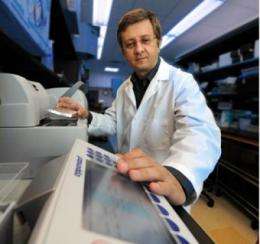Researchers search for culprit behind dry eyes, mouths and more

Researchers want to find the main culprit behind the dry, irritated eyes, mouth, throat, skin, nose and more afflicting 1-3 percent of the population.
It's called Sjögren's syndrome, a painful condition affecting moisture production that takes an average of 6.5 years to diagnose and is difficult to treat. Georgia Health Sciences University researchers say learning more about how it develops should improve diagnosis and treatment.
"We want to identify the early events just after onset of the disease so it can be diagnosed more quickly," said Dr. Rafal Pacholczyk, immunologist in the GHSU Center for Biotechnology and Genomic Medicine. "Knowing more about how the disease unfolds also will help us identify more targeted ways to treat it."
Armed with a $1.9 million grant from the National Institutes of Health, he's using a variety of mouse models to parse how the immune system begins to attack saliva, tear and other moisture-producing glands. Sjögren's blocks receptors that activate one or more of these glands, impeding messages from the brain to make tears or saliva. Gland cells also can be destroyed. A key question is which immune cells are to blame for the friendly fire.
It's the dendritic cells that scour the body for invaders, typically taking their finds to the draining lymph nodes to show T cells. Effector T cells can then initiate an attack, such as prompting B cell production of antibodies that, in this case, block receptors and attack cells. Regulatory T cells are supposed to prevent the attack on "self" tissues that occurs in autoimmune diseases such as Sjögren's. Still unidentified genes likely increase disease risk; environmental factors such as an infection may pull the trigger.
Pacholczyk is tracking T cell development in mice that start to develop Sjögren's by 8-10 weeks of age, trying to determine what causes the cells to become harmful.
He wants to identify the T cell receptors that distinguish self from non-self in this syndrome and whether the dendritic cells really are to blame. Another group of mice missing T cells enables him to use different cell combinations – such as regulatory cells from a healthy animal with effector cells from a diseased one – to see which combination produces disease. Part of what Pacholczyk wants to learn is whether fault lies with the hypersensitivity of the effector T cells or the ineffectiveness of regulatory T cells to keep them in line.
"At the end it comes down to this T cell detecting some part of a protein and deciding it's not self. Now the question becomes: Is it this the fault of the T cell recognizing something incorrectly or maybe it is the fault of the presenting cell that gives information to the T cell in a bad context?
"Once we know to what extent each arm of the immune response is at fault, we can focus on the genes that are involved and see if we can find along the way biomarkers that tell us who is predisposed to the disease or what preventive measures we can use to at least slow the disease down," he said.
Sjögren's is most often is diagnosed in women in their 40s, according to the Sjögren's Research Foundation. While the tear and salivary gland problems are disease hallmarks, moisture dysfunction can cause problems throughout the body, including the gastrointestinal tract, lungs and liver in the 4 million Americans living with the syndrome, the foundation reports.
Sjögren's often coexists with other autoimmune diseases such as lupus which can cut a wider, more destructive path across the body. Current therapies include medication to increase moisture production by cells that still function. Therapy to suppress the immune response also can help, but risk unleashing a host of other medical problems, including infection and cancer. Diagnostic tests include measuring tear and saliva flow as well as detecting autoantibodies that attack the glands and a gland biopsy to detect cell destruction.


















